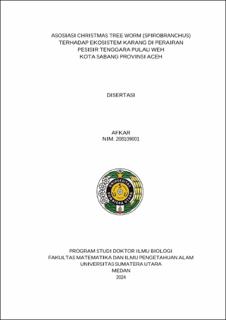Asosiasi Christmas Tree Worm (Spirobranchus) terhadap Ekosistem Karang di Perairan Pesisir Tenggara Pulau Weh Kota Sabang Provinsi Aceh
Association of Christmas Tree Worm (Spirobranchus) Towards Coral Ecosystem in Southeast Coastal Waters of Weh Island, Sabang City, Aceh Province

Date
2024Author
Afkar, Afkar
Advisor(s)
Barus, Ternala Alexander
H J, Arlen
Metadata
Show full item recordAbstract
The coral ecosystem in the waters of Weh Island has experienced severe
damage due to bleaching, so that the remaining coral colonies in the waters of
Southeast Weh Island, namely Beurawang and Jaboi, are massive coral colonies such
as Porites. Massive corals can survive the bleaching phenomenon but are vulnerable
to the presence of other species such as turf algae and Spirobranchus tube worms
(Christmas Tree Worm). The purpose of this study was to analyze; (1) the existence of
Spirobranchus species, (2) the density of Spirobranchus during the West and East
monsoons, (3) the condition of the coral occupied by the Spirobranchus population,
(4) the association of Spirobranchus density with coral conditions, (5) analyzing the
physical-chemical factors of the waters that most influence the density of the
Spirobranchus population in the waters of Beurawang and Jaboi. and (6) produce a
model of the influence of physical-chemical factors of water on the density of
Spirobranchus. This research produced; (1) Spirobranchus recommendation as a
bioindicator of coral reef health, (2) theory about Spirobranchus density on coral
cover, and (3) model of the influence of physical-chemical factors of water on the
density of Spirobranchus in Beurawang and Jaboi waters, Weh Island, Aceh Province.
The study was conducted in two periods, namely the West Monsoon (May 2022) and
the East Monsoon (October 2022) at Beurawang and Jaboi stations. The results showed
that the Spirobranchus found included S. corniculatus, S. gaymardi, S. Cruciger, and
Spirobranchus sp. The density of Spirobranchus in the East monsoon wind at
Beurawang and Jaboi stations was higher (27.61 individuals/ 30 m2), than the West
monsoon wind (22.50 individuals/ 30 m2). The condition of the coral occupied by
Spirobranchus with a density value of 17.38 individuals/30 m2 (Beurawang) and 7.68
individuals/30 m2 (Jaboi) is in good condition. However, if the individuals are more
than 20, the condition of the coral can experience a decline in health due to erosion on
the surface and the emergence of depressions in the coral.The association of
Spirobranchus with coral conditions during the West and East monsoon winds in
Beurawang waters has a 'Strong' relationship (0.771) and 'Very Strong' (0.888), while
the association in Jaboi waters has a 'Strong' relationship (0.719 and 0.722), then the
physical-chemical factor of the waters that has the most influence on the density of
Spirobranchus is Salinity with an R-Square value of 14.4%.
